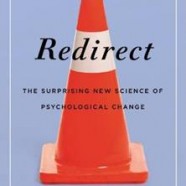
In his new book, Redirect (2011), University of Virginia Professor of Psychology–Timothy D. Wilson–observes that people’s self-views (self-beliefs) evolve from a variety of sources, beginning in one’s family-of-origin and continuing outward. Because these early influences are so foundational and formative, we can’t expect a change in views overnight. He writes:
“If a teenager is a rebel without a cause, it doesn’t do much good for his parents to implore, ‘Please change your view of yourself’ any more than it would to say, ‘I would appreciate it if you would lay off the crystal meth, lose the lip piercing, and take flute lessons.’ Narrative are often like an oil painting to which we add a little daub each day. Revising that narrative would mean scraping away layers of paint and starting over again with a fresh canvas – a daunting task, to say the least. But…sometimes it is possible to change people’s interpretations fairly easily if we find just the right approach.” (p.11)
Wilson identifies three techniques which do not supplant counseling or psychotherapy, but often facilitate “redirecting” our self-views or personal narratives. It’s somewhat analogous to changing a few key details at the start of a novel which change the story line – and outcome. These three techniques are story editing, story prompting, and do-good, be-good.
The first technique–story editing–which includes aspects of the second technique–story prompting–involves writing; for example, someone who has failed to come up with a meaningful interpretation of an important life-event can partly objectivize that event by writing and reinterpreting what happened. What often happens, instead, is that people try and force the event(s) from mind (Avoidance!) which only exacerbates the problem. Wilson again writes:
“This is exactly what the writing exercise does – it allows us to take a step back and reframe what happened. In fact, the people who benefit the most from the exercise are those who begin by writing a jumbled, incoherent account of the traumatic event, but in the end tell a coherent story that explains the event and give it meaning. At this point, the event is less likely to intrude into people’s thoughts, and they don’t have to spend psychic energy trying to suppress it.” (pp. 12-13)
Wilson admits that this writing technique is not a panacea for all psychological problems, but it has been shown to help people with a wide variety of traumatic experiences.
The third technique–do good, be good–involves changing one’s behavior first. The notion goes back as far as Aristotle–for example, Nicomachean Ethics, a classic on philosophical psychology–who suggested that people acquire virtues by putting them into practice; for example, exercising self-control to become more self-controlling. Reminds me of St. Louis Cardinal baseball pitcher Bob Gibson who admitted not always “feeling” like pitching on game day; until he got to the stadium, saw the fans, and heard the noise. The rest is “Hall of Fame” history; a good example of “acting our way into new ways of thinking and feeling.” Or, in Timothy Wilson’s words, “do good, be good!”

